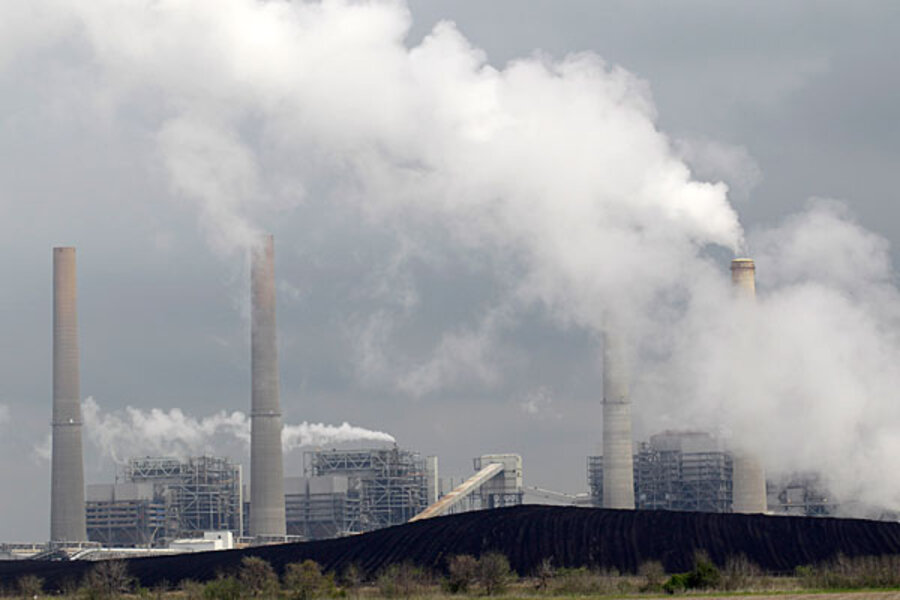In win for Obama, EPA regulations on emissions upheld by appeals court
Loading...
In a major win for the Obama administration's climate pollution policy, the US Court of Appeals for the District of Columbia Circuit ruled unanimously on Tuesday that the Environmental Protection Agency had lawfully determined that greenhouse-gas emissions pose a danger to public health and welfare.
The appeals court's decision on four major EPA initiatives to regulate carbon emissions was a clear legal victory for the Obama White House and a setback for some industry groups and states including Texas.
It was a big win as well for embattled EPA Administrator Lisa Jackson, whose controversial "endangerment finding" for greenhouse-gas emissions kicked off the legal battle royale in December 2009. Her finding followed the US Supreme Court's 2007 Massachusetts v. EPA ruling, in which the court found that carbon emissions could potentially be regulated under the federal Clean Air Act.
After that first finding, the EPA proceeded to issue other regulations to curtail carbon emissions. First came the Tailpipe Rule, in 2010, that sets carbon emission standards for cars and light trucks. With its debut, carbon emissions officially became a regulated pollutant under the Clean Air Act.
The EPA went on to determine that the Clean Air Act required the agency to regulate emissions from major stationary sources of carbon pollution, such as power plants and cement factories. Next, it determined that it would not impose a blanket rule, but rather would implement its regulations over time – starting with the largest smokestack emitters, those exceeding 75,000 tons or more of greenhouse-gas emissions per year.
The court's ruling rejected challenges to all four key EPA regulations. Backers of the Tailpipe Rule, which include US automakers, were thrilled to have one set of emissions mandates – not many states all trying to regulate vehicle emissions.
“Automakers are already producing almost 300 highly fuel-efficient models, so we have made a huge investment in technologies and want to sell these models in high numbers," said Gloria Bergquist, a spokeswoman for the Alliance of Automobile Manufacturers, an association of 12 vehicle manufacturers including Chrysler, Ford, and General Motors, in a statement. "A single national fuel economy/carbon dioxide program is among our top policy priorities to avoid the chaos arising from several different regulatory bodies each setting their own standards.”
From the start, the EPA mandates were opposed by other big industry groups and by lawmakers in Congress from coal-mining and other energy-producing states. They predicted such regulations would harm the economy.
Among them was the US Chamber of Commerce. "The Chamber has long warned that regulating greenhouse gases under the Clean Air Act would be bad for jobs and local economies," Steven J. Law, the chamber's chief legal officer and general counsel, said in a 2010 statement that called on the EPA to reconsider its endangerment finding.
When EPA did not, several states, led by Texas and an industry group called the Coalition for Responsible Regulation reportedly backed by the coal industry, filed suit. Other industry groups, including the chamber and National Petrochemical & Refiners Association, lent their support to the legal challenge, too.
The appeals court ruling by three judges – appointed by both Democratic and Republican presidents – refuted claims that the EPA had, among other things, misinterpreted the Clean Air Act and had been "arbitrary and capricious" in implementing regulatory limits on carbon emissions and requiring emitters to have permits.
"We conclude," the judges ruled, that "1) the Endangerment Finding and Tailpipe Rule are neither arbitrary nor capricious; 2) EPA’s interpretation of the governing [Clean Air Act] provisions is unambiguously correct; and 3) no petitioner has standing to challenge the Timing and Tailoring Rules."
In their ruling, the three judges also concluded that EPA's initial endangerment finding was "consistent" with the high court's 2007 decision. It was enough to buoy the EPA's long-embattled administrator.
"I am pleased that the US Court of Appeals for the D.C. Circuit found that EPA followed both the science and the law in taking common-sense, reasonable actions to address the very real threat of climate change by limiting greenhouse-gas pollution from the largest sources," Ms. Jackson said in an e-mailed statement.
Environmental groups liked the win, too.
“Today’s ruling by the court confirms that EPA’s common sense solutions to address climate pollution are firmly anchored in science and law,” Fred Krupp, president of Environmental Defense Fund, said in a statement. “Today is a good day for climate progress in America and for the thin layer of atmosphere that sustains life on Earth.”
Tuesday's ruling is probably not the end of the story. It could be appealed to the US Supreme Court. But the unanimity of the appeals court judges makes a successful appeal less likely, environmental forces argued.
“These rulings clear the way for EPA to keep moving forward under the Clean Air Act to limit carbon pollution from motor vehicles, new power plants, and other big industrial sources,” said David Doniger, senior attorney for the Climate and Clean Air Program at the Natural Resources Defense Council.
Still, lawyers for Coalition for Responsible Regulation were not ready to rule out an appeal and left their options open.
"We're still studying the 82-page opinion," Patrick Day, counsel for Coalition for Responsible Regulation, said in an interview. "Obviously we're disappointed with the outcome. What happens from here is too soon to say. We need to review all our options."







